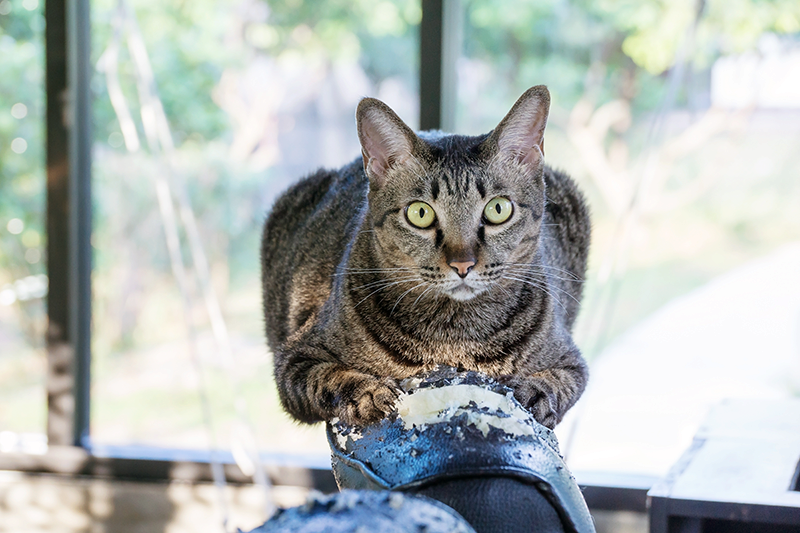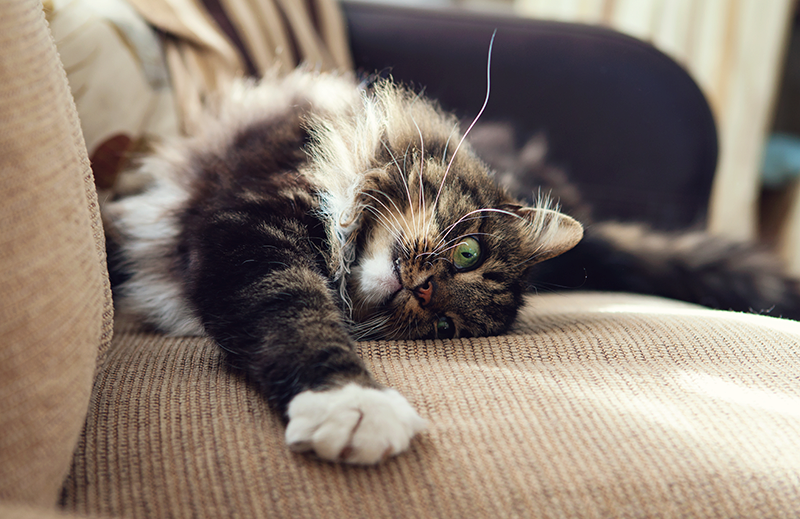Should I Declaw My Cat?
While there are so many things to love about your furry friends, fervent cat scratching can sometimes test a cat owner's patience. When a cat has whittled down his scratching post to a nub and has moved to the living room furniture, some cat owners might find themselves wondering about declawing. Declawing is very painful for cats and is not the best solution. Instead, there are many other actions you can take to help your cat develop better scratching habits.
Declawing Removes Bones & Hurts Cats
Many people think declawing cats is just a simple removal of their claws. But that's not the case. The procedure, called an onychectomy, is more invasive and painful.1 The last bone, connecting the tendons and ligaments on a cat's paw, is also removed. Side effects of declawing can include infection and nerve damage. Some cats have difficulty relearning to walk after the procedure or exhibit more unwanted (or disruptive) behaviors like avoiding the litter box or biting. In rare cases, claws end up growing back, often with difficulty.
Because of the invasive nature of declawing, it has been banned and only permitted under extreme circumstances in many countries in Europe and South America, as well as in Australia and New Zealand. Declawing is legal in North America; however, some cities have passed ordinances outlawing the procedure.
Better Ways to Stop a Cat from Scratching
Scratching is a normal feline behavior that cats use to mark their territory both visually and with scent, for claw conditioning ("husk" removal), and as a stretching activity. So what are cat owners supposed to do? You have several non-surgical ways to keep scratching from becoming too disruptive.
1. Provide Lots of Cat Scratching Posts
Provide suitable implements for normal scratching behavior like scratching posts, cardboard boxes, and carpet or fabric remnants affixed to stationary objects. Provide both horizontal and vertical scratching posts to determine which type your cat prefers. They should be tall or long enough to allow full stretching and be firmly anchored to provide necessary resistance to scratching.
To promote continued use, give your cat positive reinforcement when she uses them. You might also try sprinkling a little catnip on a new scratching post to make it more enticing.
2. Regularly Trim Your Cat's Nails
Trim your cat's claws every one to two weeks to prevent injury or damage to household items.2 Ideally, you'll get your cat used to nail clipping as a kitten. But even an adult cat can learn if you have patience and approach the process very slowly.
3. Try Nail Caps
Temporary synthetic nail caps (also called claw caps) are available to prevent human injury or property damage. Plastic nail caps are usually applied every four to six weeks.
4. Use Deterrents
Deterrents, such as foil or double-sided tape, can be used to cover sought-after places for your kitty's claws. This can help teach your cat where he shouldn't scratch and where it's okay to scratch.
5. Train Your Cat Not to Scratch
Teach your cat that vertical scratching is a no-no. Some people do this by standing guard with a squirt bottle of water, giving a light spray each time the claws come out. Some cats don't respond well to squirt bottles. You might also try a well-timed "hiss" noise when your cat is scratching the wrong area, as a way of communicating in your cat's language. Just make sure you have healthy alternatives for your cat to scratch instead.
6. Divert Your Cat's Attention
Try diverting your cat's attention by giving your cat toys to play with or getting your cat to chase you with a feather wand. This extra exercise may decrease the desire to scratch. Some cats scratch more because they have lots of pent-up energy, and extra playtime can be a big help.
7. Try Comfort Zone Products
Comfort Zone Spray & Scratch Control Spray and the Comfort Zone Calming Diffuser emit soothing pheromones to help reduce stress-related behaviors like excessive scratching. Although cats need to scratch for their health, scratching can become destructive if they're stressed. That's where Comfort Zone products can help.
Declawing shouldn't be your first option because it's far too painful for your cat. Destructive scratching can be diminished by finding healthy alternatives and decreasing any stress that might contribute to excessive scratching.
1. The Humane Society of the United States. "Declawing Cats: Far Worse than a Manicure." HumaneSociety.org, https://www.humanesociety.org/resources/declawing-cats-far-worse-manicure.
2. ASPCA. "Cat Grooming Tips." ASPCA.org, https://www.aspca.org/pet-care/cat-care/cat-grooming-tips.



